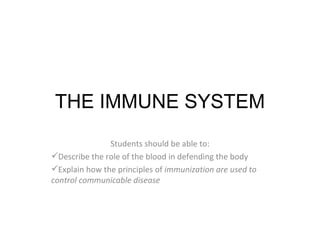
Immunity
- 1. THE IMMUNE SYSTEM Students should be able to: Describe the role of the blood in defending the body Explain how the principles of immunization are used to control communicable disease
- 2. T E R M IN O L O G Y • A N T I B I O T I C S : A drug used to treat infections caused by bacteria and other microorganisms (inhibits growth or destroys). e.g. penicillin, streptomycin, tetracycline • A N T I G E N : A toxin or other foreign substance that induces an immune response in the body, esp. the production of antibodies. • A N T I B O D Y : A blood protein produced in response to and counteracting a specific antigen
- 3. • I M M U N I T Y : The ability to resist a particular toxin by the action of specific antibodies. • I M M U N I Z A T I O N : the act of making immune (especially by inoculation, i.e. taking a vaccine as a precaution against contracting a disease). • V A C C I N E : A substance used to stimulate the production of antibodies and provide immunity against one or several diseases, prepared from the causative agent of a disease, its products, or a synthetic substitute, treated to act as an antigen without inducing the disease.
- 4. FIRST LINE OF DEFENSE • Goal: to stop pathogens from entering the body Skin – acts as a barrier to invasion Sweat – has chemicals which can kill different pathogens. Tears - have lysozyme which has powerful digestive abilities that render antigens harmless. Saliva – also has lysozyme. Mucus - can trap pathogens, which are then sneezed, coughed, washed away, or destroyed by chemicals. Stomach Acid – destroys pathogens
- 5. SECOND LINE OF DEFENSE • If a pathogen is able to get past the body's first line of defense, and an infection starts, the body can rely on it's second line of defense. • First there is a non-specific response (phagocytosis) followed by an INFLAMMATORY RESPONSE.
- 6. • Phagocytosis = ingestion + digestion of pathogens. • Phagocytic leucocytes (macrophages) engulf pathogens.
- 7. Inflammation causes: ii.Redness - due to capillary dilation resulting in increased blood flow iii.Heat - due to capillary dilation resulting in increased blood flow iv.Swelling – due to passage of plasma from the blood stream into the damaged tissue v. Pain – due mainly to tissue destruction and, to a lesser extent, swelling.
- 9. THIRD LINE OF DEFENSE • Sometimes the second line of defense is still not enough and the pathogen is then heading for the body's last line of defense, the immune system. • The immune system recognizes, attacks, destroys, and remembers each pathogen that enters the body. It does this by making specialized cells and antibodies that render the pathogens harmless. • Unlike the first line and second line defense the immune system differentiates among pathogens. • For each type of pathogen, the immune system produces cells that are specific for that particular pathogen.
- 10. • The Immune System includes all parts of the body that help in the recognition and destruction of foreign materials. • Parts of the immune system: white blood cells(phagocytes and lymphocytes) bone marrow lymph nodes tonsils thymus spleen
- 11. TYPES OF IMMUNITY P A S S IV E A C T IV E • Source: It is developed • Source: It is developed by when ready-made an individual’s own cells in antibodies are inoculated response to an infection or from outside. a vaccine. • Side effects: It may cause • Side effects: It has no side reaction. effects. • Period of relief: It provides • Period of relief: It provides immediate relief. relief only after long • Period of effectiveness: It period. is short lived • Period of effectiveness: It is long lasting.
- 12. • The natural passive immunity occurs, when the maternal IgG type antibodies is passed to the foetus through the placenta. It is very much helpful in the initial 6 months of the infant’s life when the immune system is still developing. • In the artificial passive immunity, we are introducing immunoglobulin or pre formed animal based antibodies (antiserum) to a non immune person. This can be used, following exposure, to a pathogen.
- 13. • It is named as naturally acquired active immunity because, the person develops the full fledged infection to the organism and later finds himself resistant to that organism. • In the artificial acquired active immunity, the patient is introduced with an organism (usually attenuated) along with substances to activate the immune response.
- 14. DISEASES OF THE IMMUNE SYSTEM • HAY FEVER: is your immune system's response FEVER to foreign material in the air you breathe. • Hay fever usually refers to allergies to outdoor, airborne materials such as pollens and molds. • A particular kind of antibody, IgE is released causing very sensitive reaction to the allergens. • Histamine is produced resulting sneezing, difficulty breathing, runny nose. • Antihistamines and inhalers relieve symptoms.
- 15. • ASTHMA: is a disorder that causes the airways ASTHMA of the lungs to swell and narrow, leading to wheezing, shortness of breath, chest tightness, and coughing.
Editor's Notes
- http://www.differencebetween.com/difference-between-active-and-vs-passive-immunity/
